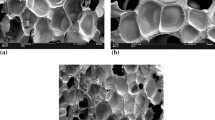Abstract
In this paper, results of research towards development of a test method for the determination of shear modulus and Poisson's ratio of polymers and structural foams are presented. Through this work, a test apparatus was developed which employed anticlastic plate bending behaviour; this device was used for calibration tests on steel and aluminium samples and for tests on a number of polymers, including high density Polyethylene (PE-HD), unplasticized Polyvinylchloride (PVC-U), Polymethylmethacrylate (PMMA) and rigid Polyurethane (PUR) foam. Long-term tests and temperature-dependent tests on PVC-U, PE-HD and PMMA samples were also performed. In some cases, results of the tests with the anticlastic bending method were compared with those obtained from tests carried out with the torsion pendulum method. For theoretical simulation, an analytical formula and a number of finite element analyses were performed. Through these simulations, values for the short-term, long-term and temperature-dependent shear modulus and Poisson's ratio of PE-HD, PMMA, PVC-U and PUR foam were obtained.
Résumé
On présente les résultats des travaux sur le développement d'une méthode d'essai pour la détermination des coefficients d'élasticité en cisaillement et des coefficients de Poisson des polymères et des mousses structurales. On a conçu un appareil d'essais utilisant le comportement en flexion anticlastique de plaques. Cet appareil a été utilisé pour des essais de calibration des échantillons d'acier et d'aluminium, ainsi que pour des essais sur des polymères, y compris le polyéthylène à haute densité (PE-HD), le chlorure de polyvinyle non plastifié (PVC-U), le polyméthacrylate de méthyle (PMMA) et la mousse rigide en polyuréthanne (PUR). Des essais de longue durée et de dépendance de la température ont également été réalisés sur les échantillons de PVC-U, de PE-HD et de PMMA. Dans certains cas, les résultats des essais par la méthode de flexion anticlastique ont été comparés aux résultats obtenus par la méthode de pendule de torsion. Une simulation théorique basée sur une formule analytique et un certain nombre d'analyses au éléments finis a été réalisée. Grâce à ces simulations, les valeurs des coefficients d'élasticité et de Poisson—à court terme, à long terme et dépendantes de la température—ont pu être obtenues pour le PE-HD, le PMMA, le PVC-U et la mousse PUR.
Similar content being viewed by others
References
Farshad, M., ‘Design and Analysis of Shell Structures’ (Kluwer Academic Publishers, Dordrecht, 1992) page 5.
Biblis, E.J. and Lee, W.C., ‘Simplification of the experimental method for determining plate shear modulus of plywood and particleboard’,Forest Products Journal 26 (4) (1976) 38–41.
ASTM D3044, Standard Test Method for Shear Modulus of Plywood (American Society for Testing and Materials, Philadelphia, 1976).
Timoshenko, S. and Woinowsky-Krieger, S., ‘Theory of Plates and Shells’, Chapter 2 and 4 (McGraw-Hill, London, 1959).
Allen, H.G., ‘Analysis and Design of Structural Sandwich Panels’ (Pergamon Press, 1969) 261–263.
Donnel, L.H., ‘Beams, Plates and Shells’ (McGraw-Hill, London, 1976) page 149.
Giles Carter, F. and Donald, E.P., ‘Materials Science and Engineering’ (ASM International, 1991).
DIN 53445, Prüfung von polymeren Werkstoffen, Torsions-schwingversuch, Beuth, Berlin 1986.
DIN 53455, Prüfung von Kunststoffen, Zugversuch, Beuth, Berlin, 1986.
Author information
Authors and Affiliations
Additional information
on project work at EMPA, Dübendorf
Editorial note M. Farshad, M. W. Wildenberg and P. Flüeler work at the EMPA, Switzerland, a RILEM Titular Member.
Rights and permissions
About this article
Cite this article
Farshad, M., Wildenberg, M.W. & Flüeler, P. Determination of shear modulus and Poisson's ratio of polymers and foams by the anticlastic plate-bending method. Mat. Struct. 30, 377–382 (1997). https://doi.org/10.1007/BF02480690
Issue Date:
DOI: https://doi.org/10.1007/BF02480690




